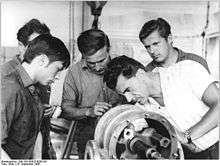Master craftsman

A master craftsman or master tradesman (sometimes called only master or grandmaster) was a member of a guild. In the European guild system, only masters and journeymen were allowed to be members of the guild.
An aspiring master would have to pass through the career chain from apprentice to journeyman before he could be elected to become a master craftsman. He would then have to produce a sum of money and a masterpiece before he could actually join the guild. If the masterpiece was not accepted by the masters, he was not allowed to join the guild, possibly remaining a journeyman for the rest of his life.
Originally, holders of the academic degree of "Master of Arts" were also considered, in the Medieval universities, as master craftsmen in their own academic field.
Today's master craftsman in different countries
United Kingdom
The Guild of Master Craftsmen continues a tradition established by the guilds of medieval Europe. The earliest of these were "frith" or "peace" guilds - groups bonded together for mutual protection following the breakdown of the kins, which were groups related by blood ties.
Merchant guilds - associations of international trades - were powerful in the twelfth and thirteenth centuries, but lost their ascendancy with the rise of the craft guilds - associations of master craftsmen, journeymen, apprentices and the various trades connected with a particular craft.
Guild of Master Craftsmen coat of arms
The world-renowned College of Arms in London awarded the coat of arms of The Guild of Master Craftsmen in 1992, after four years of assessment. Designed by heraldic expert Peter Greenhill to reflect the many categories of Guild membership, it features: three escutcheons (shields) to represent artists, painters and stainers; a pair of compasses opened in chevron for building, construction and carpenters; a dovetail (separating the top third of the shield from the rest) to represent cabinetmaking, woodworking and joinery; and a gavel and chisel for masons and stoneworkers. The southern keep of Lewes Castle, which overlooks the Guild’s headquarters, is featured above the helmet as the crest.
United States
While guilds as such do not exist, many trades continue the apprentice-journeyman-master model. Carpenters, electricians, pipefitters and plumbers are notable examples. Even in academia, the tradition survives, with elementary, middle and high school completing general education; with post secondary degrees awarded in the Associates, Bachelor and Master levels; and PhD students as apprentices, post-docs and associate professors as journeymen and full professors as masters.
The doctoral thesis which needs to be presented in order to get an academic degree, proving the student's proficiency in the chosen subject and whose quality is examined by existing lecturers, is in effect a form of the medieval masterpiece which needed to be prepared by anyone seeking to be accepted as a master in any professional guild.
The terms Master Mariner and harbormaster reflect the fact that the holders of such positions were originally Master craftsman in the Seamen's Guild. Further derived from "harbormaster" is "stationmaster", though guilds no longer existed when railways came into being.
Germany

In Germany, the master craftsman (Meister) is the highest professional qualification in crafts and is a state-approved grade. The certification is called Meisterbrief. The qualification includes theoretical and practical training in the craft as well as business and legal training. Additionally, it implies the qualification to train apprentices. These qualifications prepare the Meister for running their own business or alternatively for higher positions at a company. The status of master craftsmen is regulated in the German Gesetz zur Ordnung des Handwerks (Crafts and Trades Regulation Code).
While privileged guilds have been abolished in Germany, the ranks of apprentice (Lehrling), journeyman (Geselle) and master craftsman have been retained even through modern times. For security-relevant crafts, e.g., electricians and chimney sweeps, any business in the trade has to be run by a master craftsman or has to employ at least one Meister.
Journeymen and master craftsmen are by law automatically members of their regional chamber of crafts (Handwerkskammer), which is a self-governing public body. The chamber organizes vocational training and oversees the examination of the journeymen and masters.
To become a master craftsman, it is usually required to have completed vocational training in the craft in which the examination should be taken, which finishes with a final examination called Gesellenprüfung (journeyman's examination), and to have practical experience of at least 3 to 5 years as a journeyman (Geselle). If these requirements are fulfilled, the candidate can take courses for the Meisterprüfung (master craftman's examination). The duration of the courses takes 4 to 6 years depending on the craft. The examination includes theoretical, practical and oral parts and takes 5 to 7 days (depending on the craft). In some crafts, the creation of a masterpiece is also part of the examination.
The German Meister qualifies the holder to study for a bachelor's degree at University, whether the Meister holds a regular university entrance qualification or not.[1] According to the German Qualifications Framework, the Meisterbrief is at the same level as a bachelor's degree, even though it is not an academic degree and thus not directly comparable.[2]
See also
References
- ↑ Hochschulzugang für beruflich qualifizierte Bewerber ohne schulische Hochschulzugangsberechtigung. ANKOM. 3 March 2009.
- ↑ "Der Deutsche Qualifikationsrahmen für Lebenslanges Lernen". bmbf.de (in German). German Federal Ministry of Education and Research. 16 May 2013. Retrieved 2016-10-30.
External links
- Website of German craft chambers
- The Guild of Master Craftsmen
- The Woodworkers Institute
- Deutscher Qualifikationsrahmen
- Meister equivalent bachelor, German Government